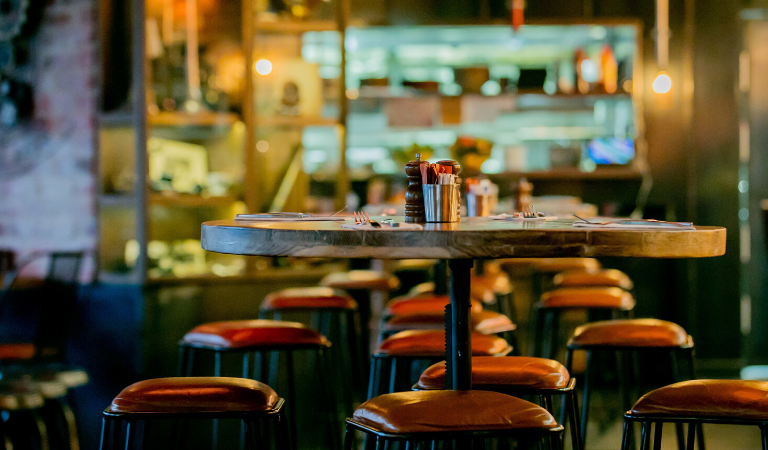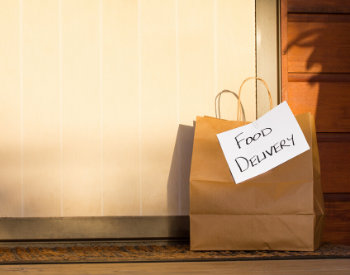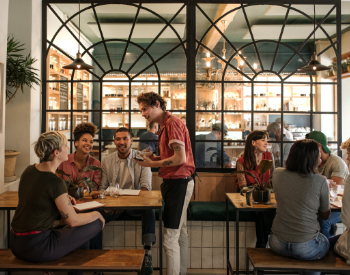Wondering what COVID-19 will impact next has become the new normal in daily life. The National Restaurant Association estimates a $225 billion loss for restaurants due to the ripple effects of the coronavirus outbreak. As industries continue to struggle under the weight of unexpected closures, the following months seem uncertain, yet full of possibilities.
For all those working in the restaurant and hospitality industry, resilience and innovation is just part
of the job. In an interview with Restaurant Business Online the CEO of Garbanzo Mediterranean Fresh,
James Park, said that the level of entrepreneurial spirit and commitment is going to roar this industry
back. He believes that the industry will be much stronger and much more efficient on the other side of
this. If you’re looking towards an uncertain future for your foodservice establishment or catering
business, here is some helpful insight on what experts are predicting the restaurant industry will look
like after COVID-19.
The Potential Lows Of The Restaurant Industry
In March, the National Restaurant Association conducted surveys to estimate the state of the restaurant industry. The goal was to measure the impact of the COVID-19 crisis on the restaurant industry.
- 3% of operators report permanently closing
- 11% predict permanent closures within 30 days
- Around 30,000 restaurants have already closed
- 110,000 more businesses will close in the near future
The restaurant industry is facing unpredictable changes in the following months. For restaurant owners and employees, this means that the resurgence a potential boom would bring isn’t going to be immediate. As consumers adjust to life after coronavirus, many will find themselves carrying the same fears on health and safety they’ve had during the pandemic. Coupled with an economic recession, the general public will likely spend less and avoid full-service dining during this time.
Many independent restaurants and cafes may not survive extended closures, while franchisees face potentially exhausting their emergency funds. This means that restaffing your business and reimplementing new health and safety standards will be difficult to do, due to unknown costs. Food supply shortages may inflate the price of ingredients, which could provide unexpected challenges as your restaurant attempts to reopen to the public. Rebranding and bringing back consumer trust will play a huge role in returning steady traffic to your restaurant. It will require in-depth marketing and constant changes based on the needs of your customers.
How Operators Can Adjust To Changes In The Industry
Above all, being prepared to handle all the potential changes in the restaurant industry is the most important tactic when it comes to adjusting to a ‘new normal’. One of the biggest challenges your business faces is the loss of consumer trust. Written in a statement from Restaurant Business Online, Jeff Chandler, CEO of Hopdoddy Burger Bar, believes that there are some industry trends that will need to become a permanent part of your business, based on how customers are behaving during the pandemic.
“Off-premise will remain a strong component of the business once we get back and fully lean into this new normal,” Chandler said. "People aren’t going to want to touch a kiosk, they are going to want to order from a person, where they don’t have to touch anything, or through their own mobile device.”
The ‘New Normal’
Understanding what this ‘new normal’ will look like is key to making the needed adjustments at your foodservice establishment. Experts from Datassential have taken data from consumers across the United States to hear their thoughts and concerns on a return to normalcy after social distancing measures are eased. Below are some helpful statistics in gauging consumer behavior.
- 35% of consumers feel somewhat comfortable returning to restaurant dining areas.
- 22% of consumers feel somewhat comfortable returning to bars and nightclubs.
- 41% of consumers miss dining at their favorite sit-down restaurants.
- 23% of consumers miss attending events at arenas, stadiums, and other venues.
- 33% of consumers want to support their local restaurants during this time.
- 71% of consumers expect and require stricter health and cleaning standards at restaurants.
What Consumers Are Thinking
Overall, the precautions of COVID-19 and enforced social distancing has left consumers feeling anxious yet ready to begin dining at restaurants once this has passed. Experts at Datassential also expect these percentages to rise amongst consumers during the following months. To prepare for this, your business needs to invest in new cleaning measures at your establishment, health standards for employees, and several changes to the layout of your full-service facility.
Here’s a list of possible solutions to the necessary adjustments your restaurant needs in order to gain back consumers’ trust:
- Contactless payment
- Mobile ordering
- Permanent curbside pickup and delivery
- Spit guards and food covers at high-touch areas
- Food safety apparel like masks, gloves, and hairnets
- Health benefits for employees
- No communal seating
- Disposable cutlery and tableware
- Visible cleaning inspections such as hourly wipe-downs of all surfaces
A Renewal Of The Restaurant Industry
To counter the possibility of a potential downfall in the restaurant industry, it's likely that there will be a renewal in full-service dining and a surge in sales in the future. With the enforcement of self-isolation and social distancing taking place across the country, consumers are anxious to return to everyday life. People miss sitting at cafes, dining at their favorite restaurants, and spending time with loved ones outside of their home. The experts at Datassential also conducted a survey amongst consumers to gain insight on their thoughts on social isolation and what they’re looking forward to as the spread of coronavirus subsides.
- 58% of consumers are looking forward to dining at restaurants just to feel ‘normal again’.
- 26% of consumers are tired of cooking at home.
- 38% of consumers feel like they’ve been stuck at home for too long.
- 20% of consumers are looking forward to dinner dates and celebrating special occasions.
- 43% of consumers are looking forward to a change in scenery and daily routine.
Datassential experts also expect these numbers to rise drastically as social distancing measures continue throughout the following months. One thing is certain though: consumers are craving a return to normalcy and your foodservice establishment is a part of that. A renewed interest in restaurants will bring a surge in sales, traffic, and regular business. When experiencing the effects of a potential financial downfall, consider how your business should prepare for this potential boom.
How Restaurants Should Prepare For The Future

Retraining staff and stocking up on supplies to fuel an increase in orders are imperative. Catering services will expect to see a surge in events later down the road and should plan accordingly. Take out and delivery practices will be a permanent part of your business, and your restaurant should be fully equipped to meet the needs of digital customers. With fewer competitors amongst local businesses and large food chains, focus on marketing your establishment to get ahead of the curve. If you haven’t invested in marketing your restaurant, now's a great time to do so, as it will be needed to get your restaurant to stand out in the minds of consumers during this time.
Looking Ahead
Although the future of the restaurant industry is unpredictable, all we can do is prepare for the best and the worst. Taking into consideration the kind of financial burdens businesses and consumers will undoubtedly face is important, but looking towards the benefits and possibilities of resurgence is equally as important. Those who work in the restaurant industry know how often resilience and innovation shines through, even in these troubling times.








